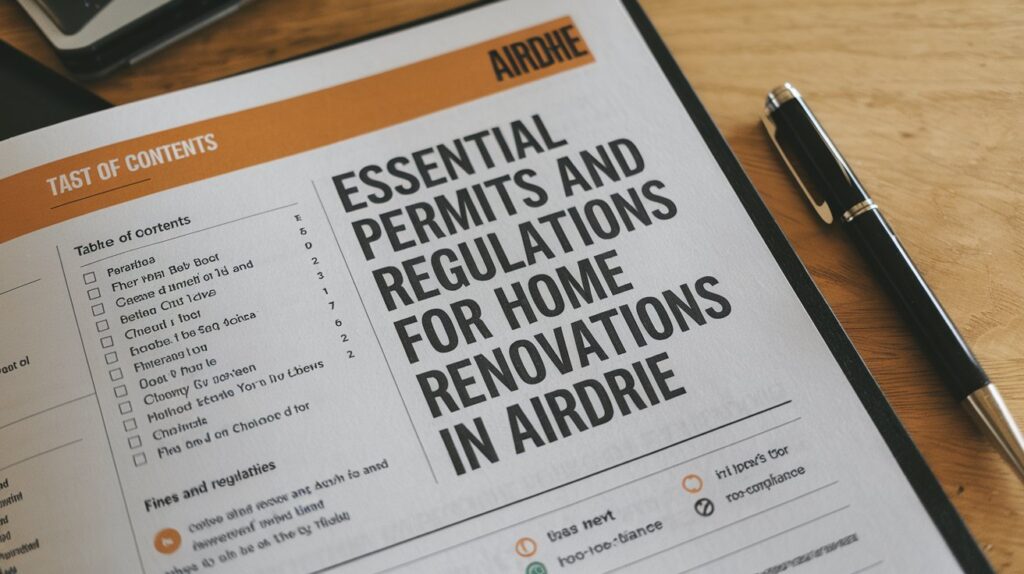Renovating your home in Airdrie requires careful attention to permits and regulations to secure compliance and avoid costly penalties. Key permits include building, electrical, plumbing, and demolition permits, while zoning laws dictate how you can use your property. Understanding these requirements not only protects your investment but also secures the safety and legality of your project. Consulting professionals who specialize in home renovations in Airdrie can help streamline the process.
Table of Contents
- Understanding Local Building Codes and Zoning Laws
- Types of Permits You May Need for Your Renovation
- Step-by-Step Guide to Obtaining Permits
Imagine this: You’ve spent months dreaming about your ideal kitchen renovation – sleek countertops, modern appliances, and a functional layout. But just as construction begins, you receive a notice from the city halting your project because you failed to secure the necessary permits. Unfortunately, this scenario is more common than many homeowners realize.
Whether you’re planning a simple update or a major overhaul, understanding local regulations is essential. For instance, before starting any renovation, it’s wise to consult with experts who specialize in home renovations in Airdrie. These professionals can guide you through the intricacies of permits and secure your project adheres to all legal requirements. In this article, we’ll walk you through everything you need to know to keep your renovation on track, from permits to common mistakes to avoid. Let’s get started!
Understanding Local Building Codes and Zoning Laws
When it comes to home renovations, local building codes and zoning laws are more than just bureaucratic red tape – they’re designed to secure safety, structural integrity, and harmony within your community. These regulations vary depending on where you live, but their purpose remains consistent: to protect homeowners, contractors, and neighbours alike.
Building codes, for instance, outline specific standards for construction practices, materials, and safety measures. Whether you’re rewiring your home or adding an extension, these codes dictate how the work should be done. Similarly, zoning laws govern how properties in certain areas can be used. For example, some neighbourhoods may restrict additions that exceed a specific height or encroach on setback requirements.
To better understand these rules, let’s break them down into key components:
- Setback Requirements: These dictate how far structures must be from property lines. For instance, a front-yard setback might require your home’s exterior wall to be at least 5 meters from the street.
- Height Restrictions: Many municipalities limit how tall a structure can be, securing it aligns with the neighbourhood’s aesthetic and doesn’t obstruct views.
- Lot Coverage Limits: This refers to the percentage of your lot that can be covered by buildings, preventing overcrowding on your property.
Here’s a quick reference table summarizing common zoning restrictions based on property types:
| Property Type | Setback Requirements | Height Restrictions | Lot Coverage Limit |
| Single-Family Home | 5m front, 3m side | 9m max | 35% |
| Multi-Family Dwelling | 6m front, 4m side | 12m max | 40% |
| Accessory Buildings (e.g., sheds) | 1m setback | 4m max | N/A |
Types of Permits You May Need for Your Renovation
Before you pick up a hammer or call your contractor, it’s crucial to understand the various permits that might be required for your home renovation project. These permits are not just formalities – they secure your project complies with safety standards, structural integrity guidelines, and municipal regulations. Skipping them can lead to fines, delays, or even forced removal of unauthorized work. Let’s explore the most common types of permits you may encounter during your renovation journey:
1. Building Permit
A building permit is often the first step for any structural changes to your home. This includes:
- Adding an extension, such as a second story or a sunroom.
- Building a deck or patio that exceeds a certain size.
- Removing or altering load-bearing walls.
- Finishing a basement or converting it into a living space.
Without this permit, your municipality cannot verify that the work meets safety and zoning requirements.
2. Electrical Permit
Any electrical work – big or small – requires an electrical permit. Examples include:
- Installing new outlets, light fixtures, or ceiling fans.
- Upgrading your electrical panel to accommodate increased power needs.
- Rewiring parts of your home for modernization or safety purposes.
Electrical work must comply with the Canadian Electrical Code (CEC), and inspections are often mandatory to secure everything is up to standard.
3. Plumbing Permit
If your renovation involves plumbing, this permit is non-negotiable. It covers tasks such as:
- Replacing or installing new pipes, sinks, or toilets.
- Moving plumbing fixtures to a different location.
- Repairing sewer lines or water heaters.
Many municipalities also encourage eco-friendly practices, so consider incorporating water-saving fixtures into your plans.
4. Demolition Permit
Planning to tear down a wall or remove part of your home? A demolition permit secures that the process is done safely and doesn’t compromise your home’s structure. This is especially important if you’re removing load-bearing walls or significant portions of your property.
5. Mechanical Permit
For renovations involving heating, ventilation, or air conditioning (HVAC) systems, a mechanical permit is essential. This includes:
- Installing a new furnace or air conditioning unit.
- Modifying ductwork or ventilation systems.
- Adding energy-efficient upgrades like heat pumps.
These permits secure that your HVAC modifications meet energy efficiency and safety standards.
Step-by-Step Guide to Obtaining Permits

Securing permits might seem like a daunting task, but breaking it down into manageable steps can make the process much smoother. By following this guide, you’ll secure your renovation project complies with local regulations and avoids unnecessary delays or fines. Let’s walk through the process step by step:
1. Research Local Requirements
Every municipality has its own set of rules, so it’s essential to start by understanding what’s required in your area. For instance:
- Visit your city’s official website for detailed information on building codes, zoning laws, and permit fees.
- Contact the local planning or building department if you’re unsure about specific requirements.
- Look for online portals where you can submit applications or check the status of your permits digitally.
Many municipalities also provide helpful resources, such as FAQs, guides, or even workshops for homeowners planning renovations.
2. Prepare Documentation
Once you know what’s required, gather all necessary documents to support your application. This typically includes:
- Blueprints or Site Plans: Detailed drawings of your proposed changes, including dimensions and structural details.
- Scope of Work: A written description of the project, outlining what will be done and why.
- Property Information: Proof of ownership or legal authorization to make changes to the property.
- Energy Efficiency Details: If applicable, include plans for eco-friendly upgrades, such as insulation or solar panels.
Pro tip: Double-check your documents for accuracy before submission – missing or incorrect information can delay approval.
3. Submit Your Application
With your paperwork in order, it’s time to submit your permit application. Here’s how to do it effectively:
- Pay Attention to Fees: Permit costs vary depending on the scope of your project. Be prepared to pay upfront when submitting your application.
- Choose the Right Channel: Some municipalities allow online submissions, while others require in-person visits or mailed applications.
- Keep Copies: Always retain copies of your application and supporting documents for your records.
After submission, you’ll typically receive a tracking number, which you can use to monitor the status of your application.
4. Schedule Inspections
Once your permit is approved, inspections by professionals (for example, NJL Renovations) are often required at key stages of your renovation. These inspections secure the work aligns with approved plans and meets safety standards. Common inspection points include:
- Foundation Work: securing footings, walls, and supports are structurally sound.
- Framing: Verifying that walls, floors, and roofs are built to code.
- Electrical and Plumbing: Checking wiring, outlets, pipes, and fixtures for compliance.
- Final Inspection: A comprehensive review once the project is complete.
Be sure to schedule inspections promptly – delays here can hold up the entire project.
5. Address Feedback and Make Adjustments
If an inspector identifies issues during a review, don’t panic. They’ll provide a list of corrections needed to bring your project up to code. Common fixes include:
- Reinforcing structural elements that don’t meet load-bearing requirements.
- Upgrading electrical systems to handle increased capacity.
- Resolving plumbing leaks or improper venting.
Once corrections are made, schedule a follow-up inspection to secure everything is now compliant.
Final Thoughts: Securing a Smooth Renovation Journey
The housing renovation is a fascinating task that provides a person with the possibility to make a place where they really feel at home. Nevertheless, the process has the possibility to be complex, particularly when venturing through regulations and permits. The key when completing any project, including the one you have been assigned, is to plan ahead and take every little detail into consideration, thus reducing the amount of stress and keeping everything on schedule.
Among the biggest lessons to be learnt is that preparation is rewarding. Learning which local codes to pay attention to, acquiring the proper permits, and the like is another aspect that you will need to take time to do your homework on before making a costly error. Bear in mind that it is not about obeying the rules only; it is about preserving your investment and being able to secure the safety and durability of your home.

